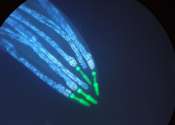Muscular dystrophy (abbreviated MD) refers to a group of genetic, hereditary muscle diseases that weaken the muscles that move the human body. Muscular dystrophies are characterized by progressive skeletal muscle weakness, defects in muscle proteins, and the death of muscle cells and tissue. Nine diseases including Duchenne, Becker, limb girdle, congenital, facioscapulohumeral, myotonic, oculopharyngeal, distal, and Emery-Dreifuss are always classified as muscular dystrophy but there are more than 100 diseases in total with similarities to muscular dystrophy. Most types of MD are multi-system disorders with manifestations in body systems including the heart, gastrointestinal and nervous systems, endocrine glands, skin, eyes and other organs.
In the 1860s, descriptions of boys who grew progressively weaker, lost the ability to walk, and died at an early age became more prominent in medical journals. In the following decade, French neurologist Guillaume Duchenne gave a comprehensive account of 13 boys with the most common and severe form of the disease (which now carries his name — Duchenne muscular dystrophy). It soon became evident that the disease had more than one form, and that these diseases affected males of all ages.[citation needed]









